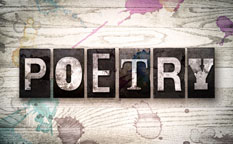
Poetry Writing
Poetry writing is one of the most challenging forms of creative writing to master. It can seem daunting, especially if you feel like you are not naturally creative. However, if you nail this art form, it can be a very fulfilling creative venue. Fortunately there are numerous poetry examples online to learn from.
If you want to give Poetry writing a try, this guide will provide you with some general parameters and pointers as guideposts. Continue reading to learn how you can write a poem that you will be proud to share with the world.
Defining Poetry writing
People have a broad range of opinions on what should and shouldn't be considered poetry. In the past, poems rhymed and had a regular rhythm. Today, what passes for a poem depends on who you ask. The definition of poetry is often romanticized with responses like: "Poetry is a speaking picture" or "a concentration of the power of language."
If you are looking for a definition, such musings are not helpful. The best way to understand poetry is to highlight the differences that separate it from prose. These include:
- Line structure
While prose is made up of sentences, poetry is typically organized into lines. The margin determines where the lines in prose end, but in poetry, the poet decides. This choice determines how the poem appears and sounds. It affects the speed at which a poem is read, where the reader pauses, and which words stand out more than others.
- Physical aspects
Communication in poetry, more than prose, is dependent on how words appear and sound. The meaning, sound, and rhythm of the words that make up a poem work together to create an emotional impact on the audience.
- Concentrated language
Compression or concentrated language is an important characteristic of poetry. A small poem can pack as much meaning as a larger amount of prose. This is because the words in poems perform multiple jobs simultaneously. The words can have one message in their meaning and another in their sound. The meaning can even be multi-level.
- Emotional connection
Prose typically engages the logical part of a reader's mind. It makes sense by explaining and describing things. Poetry comes from deep places within a poet and touches something similarly deep in the reader. While poetry also tries to explain and describe, it also engages the audience at an emotional level. Often what elicits the most potent emotions is what a poem makes the reader imagine as opposed to what it describes.
Structure of a poem

A poem's structure can refer to several things, but the physical structure is the most significant. Just like the sentence is the building block of prose, a poem is made up of poetic lines. Poetic lines make up stanzas. Ideas in poems are usually organized into stanzas.
The poet generally determines the length of the poetic line. The line breaks and length of the lines have a significant impact on the reader's experience. These impacts include:
- The sound of the poem
- The speed of reading
- Its appearance on the page
- Emphasis placed on the words
Types of poetic lines
Poems have different types of lines either dictated by the poet or the rules of the form. They include:
- End-stopped lines: They stop at natural stopping points or the end of a sentence, and they make the reader take a little pause.
- Run-on or enjambed lines: They stop mid-sentence and interrupt the natural flow causing a suspenseful or startling effect or highlighting pa double meaning in a phrase.
Form of a poem
The poem's form is its physical structure. Decisions about form include line length, line breaks, speed, arrangement, and rhythm. The poem's content and purpose determine its form. The different types of poetry forms include:
- Sonnet - A short, 14-line rhyming poem.
- Acrostic - Each line starts with a letter that spells a word that exposes a more profound meaning or fits with the poem's theme
- Epic - A lengthy narrative poem praising the accomplishments or adventures of heros
- Haiku - A 3-line poem with five syllables in the first line, 7 in the middle, and 5 in the last.
- Couplet - Two lines that rhyme and make up a stand-alone poem or part of a poem.
- Free verse - Free written poetry that does not follow any rules.
Writing the poem
1. Finding material
The first step in Poetry writing is coming up with a subject to write about. Most budding poets struggle with finding profound material. The thing about poetry is that they can be about anything. Poetry topics vary but what makes any of it interesting or profound is the hidden details or unique perspective on the subject. Write about something that is nearby or that you have experienced first-hand.
2. Getting outside yourself
Worrying about your poem's style can distract you from the content and end up hurting your poem. The best approach when writing a poem is concentrating on the subject matter and not on yourself. Even when the poem is about yourself, you should take the perspective of a reporter.
3. Expressing your insights
Avoid stating the obvious but do not force originality. Focus on finding real, unique details about the subject matter. Use the right words to express your subject matter but do not try to be poetic or impressive. The meaning and sound of words create different feelings.
Final Thoughts
There is a lot to consider when writing poetry. Reading poetry examples and writing your own poems on various poetry topics is the only way to get better at it. Start small and advance gradually until you can write poetry effortlessly.
Sources

